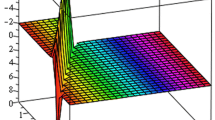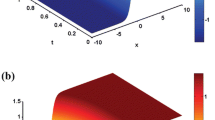Abstract
The modified simple equation method is an interesting technique to find new and more general exact solutions to the fractional differential equations in nonlinear sciences. In this paper, the method is applied to construct exact solutions of (2+1)-dimensional conformable time-fractional Zoomeron equation and the conformable space-time fractional EW equation.
Similar content being viewed by others
Avoid common mistakes on your manuscript.
1 Introduction
Fractional calculus have been one of the most intensively developing areas of mathematical analysis, including several definitions of fractional operators like Riemann-Liouville, Caputo, and Grünwald-Letnikov. It implies the calculus of the differentiation and integration whose order is given by a fractional number. The history of the fractional derivatives goes back to the seventeenth century Diethelm (2010), Oldham and Spanier (1974), Podlubny (1999).
Nonlinear fractional partial differential equations (NFDE) play an important role due to its application in various fields of science not only in physics, but also in engineering, optimal problem, finance, chemistry and biology. So obtaining solutions of these equations have become more important. Therefore, many new methods have been introduced. For example, sub equation method Sahoo and Saha Ray (2015), \((G^{\prime }/G)\)-expansion method Bekir et al. (2016), Kudryashov method Demiray et al. (2014), modified Kudryashov method Hosseini et al. (2017), Korkmaz (2017) trial equation method Gurefe et al. (2011), homotopy analysis method Pandir et al. (2014), first integral method Cenesiz et al. (2017), Eslami and Rezazadeh (2016) and so on Unal and Gokdogan (2017), Ekici et al. (2016), Guner et al. (2017a, b).
The text below is organized in the following way. In Sect. 2, brief of conformable fractional derivative is given. Then in Sect. 3, the modified simple equation method is presented. In Sect. 4, applications of the method are given. Finally we give some conclusions.
2 Brief of conformable fractional derivative
Recently, the authors Khalil et al. (2014) introduced a new simple well-behaved definition of the fractional derivative called conformable fractional derivative. In this section, we give the brief of conformable fractional derivative.
Definition 1
Suppose that \(f=f(t)\) be a function defined on the positive half space. Then, the conformable fractional derivative of f of order \(\alpha\) is defined as
for all \(t>0\), \(\alpha \in \left( 0,1\right]\) and \(f:\left[ 0,\infty \right) \rightarrow\) Some useful properties can be listed as follows: \(\cdot D_{t}^{\alpha }(af+bg)=a(D_{t}^{\alpha }f)+b(D_{t}^{\alpha }g)\), for all \(a,b\in\)
-
\(\cdot D_{t}^{\alpha }(t^{p})=pt^{p-\alpha },\) for all \(p\in\)
-
\(\cdot D_{t}^{\alpha }(\lambda )=0\), for all constant functions \(f(t)=\lambda\)
-
\(\cdot D_{t}^{\alpha }(fg)=fD_{t}^{\alpha }(g)+gD_{t}^{\alpha }(f)\)
-
\(\cdot D_{t}^{\alpha }(f/g)=\frac{g(D_{t}^{\alpha }f)-f(D_{t}^{\alpha }g)}{ g^{2}}\)
Additively, if f is differentiable, then \(D_{t}^{\alpha }(f)(t)=t^{1-\alpha }\frac{df}{dt}(t)\).
Theorem
Let \(f:(0,\infty )\rightarrow\) be a differentiable and \(\alpha -\) conformable differerentiable function and also g be a differentiable function defined in the range of f. Then the following property holds
Here \(^{\prime }\) denotes the derivative with respect to \(\alpha\).
3 Method of finding solutions
In this section, we illustrate the main idea of the MSE method Kaplan et al. (2015). A NFDE in the sense of the conformable derivative is given as follows
By making use of the following transformation
where k, h and l are nonzero arbitrary constants. Equation (3) can be reduced to an ordinary differential equation (ODE) as follows:
Determine the positive integer m in the formula Eq. (6) by equating the highest power of the nonlinear term(s) and the highest power of the highest order derivative of Eq. (5). We seek the solution in the form
Here \(\vartheta \left( \xi \right)\) is an unknown function. Substituting Eq. (6) into Eq. (5) and setting the coefficients of \(\left[ \frac{\vartheta ^{^{\prime }}\left( \xi \right) }{ \vartheta \left( \xi \right) }\right] ^{n}\) to be zero, one obtains an over-determined nonlinear algebraic equation in \(a_{n}(n=0,1,\ldots ,m), \vartheta \left( \xi \right)\) and its derivatives, k and l. Finally substitution of these values into Eq. (6) completes the determination of exact solutions of Eq. (3).
Note: Here \(\vartheta \left( \xi \right)\) is the auxiliary function of the modified simple equation method. It is not a solution of any pre-defined or known function. Thus, the modified simple equation method gives more fresh solutions.
4 Applications of the method
4.1 (2+1)-dimensional conformable time-fractional Zoomeron equation
Let us apply the above methodology to the (2+1)-dimensional conformable time-fractional Zoomeron equation Zhou et al. (2015)
which is a convenient model to display the novel phenomena associated with boomerons and trappons. We substitute the following transformation into Eq. (7)
and then the following ODE is obtained.
Integrating twice Eq. (9) with respect to \(\xi\) results the following equation
where a is a non-zero integration constant. Here the balancing number is found as \(m=1\). Therefore, the solution of Eq. (10) is of the form:
where \(a_{0}\) and \(a_{1}\) are constants to be determined and \(\vartheta \left( \xi \right)\) is an unknown function. Substituting Eq. (11) into Eq. (10), and vanishing all coefficients of each order of \(\vartheta \left( \xi \right) ,\) we obtain a set of over-determined algebraic equations as follows:
Solving these algebraic equations with the help of computer algebra, we obtain
and then we substitute Eq. (13) into the reminder of the system to find:
Then by substituting Eqs. (13) and (14), we get
where \(\xi =kx+hy-l\frac{t^{\alpha }}{\alpha }\).
4.2 The conformable space-time fractional EW equation
The space-time fractional EW equation Korkmaz (2017)
where a and c are positive parameters. This equation is used to model nonlinear dispersive waves. The fractional EW is defined in the positive half space since conformal derivative is defined only in positive domains.
Employing the transformation Eq. (17),
Equation (16) can be reduced to an ODE. Then integrating this equation once with respect to \(\xi\) by taking the integration constant to zero gives the following equation
According to MSE method, the exact solution of the reduced equation can be taken as
Substitution of Eq. (19) the into Eq. (18) provides to obtain following algebraic equation system:
We find
from the first equation of Eq. (20) and
from the last equation of Eq. (20). Thereafter, we substitute these values into the reminder of the system. Let us deal with two cases arising out of different values of \(a_{0}\).
Case 1 When \(a_{0}=0\), equation system (20) is reduced to:
When we solve this system we obtain
and
Finally by substituting these values into Eq. (19), we verify the exact solution of the conformable space-time fractional EW equation
where \(\xi =k\frac{x^{\alpha }}{\alpha }-l\frac{t^{\alpha }}{\alpha }\).
Case 2 Let us discuss the case \(a_{0}=\frac{l}{ ak}\). In this case equation system (23) takes the form:
Then, we solve the system above to find
and
Finally, we substitute the values of \(a_{0},a_{1},\) \(a_{2}\) and \(\vartheta (\xi )\) into Eq. (19) to obtain:
where \(\xi =k\frac{x^{\alpha }}{\alpha }-l\frac{t^{\alpha }}{\alpha }\).
5 Conclusions
In this work, we have discussed the new definition for traveling wave transformation and new conformable fractional derivative to converting the NFDEs into the ODEs and its applications to the (2+1)-dimensional conformable time-fractional Zoomeron equation and the conformable space-time fractional EW equation. In this paper, different cases of the balancing number are came up. The MSE method is applied to the model reveals soliton solutions. Since the technique is direct and powerful it can be used to handle a variety of FPDE’s which appears in applications in several branch of the nonlinear sciences. In additional to algorithms can be applied to obtain such soliton solutions so that a complete picture can be drawn.
References
Bekir, A., Guner, O., Ayhan, B., Cevikel, A.C.: Exact solutions for fractional differential-difference equations by \((G^{\prime }/G)\)-expansion method with modified Riemann-Liouville derivative. Adv. Appl. Math. Mech. 8(02), 293–305 (2016)
Cenesiz, Y., Baleanu, D., Kurt, A., Tasbozan, O.: New exact solutions of Burgers’ type equations with conformable derivative. Waves Random Complex Media 27, 103–116 (2017)
Demiray, S.T., Pandir, Y., Bulut, H.: The investigation of exact solutions of nonlinear time-fractional Klein-Gordon equation by using generalized Kudryashov method. AIP Conf. Proc. 1637, 283–289 (2014)
Diethelm, K.: The Analysis of Fractional Differential Equations. Springer, Berlin (2010)
Ekici, M., Mirzazadeh, M., Eslami, M., Zhou, Q., Moshokoa, S.P., Biswas, A., Belic, M.: Optical soliton perturbation with fractional-temporal evolution by first integral method with conformable fractional derivatives. Optik 127(22), 10659–10669 (2016)
Eslami, M., Rezazadeh, H.: The first integral method for Wu-Zhang system with conformable time-fractional derivative. Calcolo 53, 475–485 (2016)
Guner, O., Bekir, A., Korkmaz, A.: Dark soliton solutions of space-time fractional Sharma-Tasso-Olver and Potential Kadomtsev-Petviashvili equations. Commun. Theor. Phys. 6(2), 182–188 (2017a)
Guner, O., Korkmaz, A., Bekir, A.: Tanh-type and sech-type solitons for some space-time fractional PDE models. Eur. Phys. J. Plus 132(2), 92 (2017b)
Gurefe, Y., Sonmezoglu, A., Misirli, E.: Application of trial equation method to the nonlinear partial differential equations arising in mathematical physics. Pramana J. Phys. 77(6), 1023–1029 (2011)
Hosseini, K., Mayeli, P., Ansari, R.: Modified Kudryashov method for solving the conformable time-fractional Klein-Gordon equations with quadratic and cubic nonlinearities. Optik 130, 737–742 (2017)
Kaplan, M., Bekir, A., Akbulut, A., Aksoy, E.: The modified simple equation method for nonlinear fractional differential equations. Rom. J. Phys. 60(9–10), 1374–1383 (2015)
Khalil, R., Al Horani, M., Yousef, A., Sababheh, M.: A new definition of fractional derivative. J. Comput. Appl. Math. 264, 65–70 (2014)
Korkmaz, A.: Exact solutions of space-time fractional EW and modified EW equations. Chaos Soliton Fractals 96, 132–138 (2017)
Korkmaz, A.: Exact solutions to (3+1) conformable time fractional Jimbo-Miwa, Zakharov-Kuznetsov and Modified Zakharov-Kuznetsov equations. Commun. Theor. Phys. 67(05), 479–482 (2017)
Oldham, K.B., Spanier, F.: The Fractional Calculus. Academic Press, New York (1974)
Pandir, Y., Baskonus, H.M., Bulut, H.: On the solution of nonlinear time-fractional generalized burgers equation by homotopy analysis method and modified trial equation method. Int. J. Model. Optim. 4(4), 305–309 (2014)
Podlubny, I.: Fractional Differential Equations. Academic Press, San Diego (1999)
Sahoo, S., Saha Ray, S.: Improved fractional sub-equation method for (3+1)-dimensional generalized fractional KdV-Zakharov-Kuznetsov equations. Comput. Math. Appl. 70, 158–166 (2015)
Unal, E., Gokdogan, A.: Solution of conformable fractional ordinary differential equations via differential transform method. Optik 128, 264–273 (2017)
Zhou, Y., Cai, S., Liu, Q.: Bounded traveling waves of the (2+1)-dimensional Zoomeron equation. Math. Probl. Eng. 2015, 163597 (2015)
Author information
Authors and Affiliations
Corresponding author
Rights and permissions
About this article
Cite this article
Kaplan, M., Bekir, A. & Ozer, M.N. A simple technique for constructing exact solutions to nonlinear differential equations with conformable fractional derivative. Opt Quant Electron 49, 266 (2017). https://doi.org/10.1007/s11082-017-1105-5
Received:
Accepted:
Published:
DOI: https://doi.org/10.1007/s11082-017-1105-5




